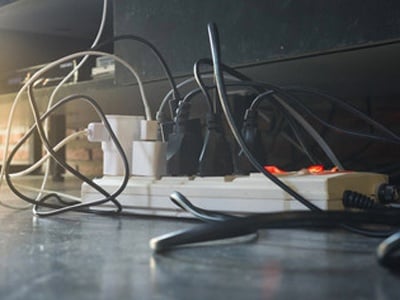
As businesses increasingly monitor their energy usage, plug loads tend to be overlooked. And that’s a costly mistake, according to the U.S. General Services Administration (GSA).
Plug loads come from equipment that’s plugged into a standard 120V outlet. Some of the most common plug loads include computers, monitors, printers, copiers, telephones and task lighting. Coffeemakers and water coolers are other ongoing energy drains.
Plug loads account for more than 30 percent of energy usage in offices, according to the GSA. They result in more than 700,000 metric tons of carbon dioxide emissions per year, which is equivalent to the emissions from 140,000 cars.
The GSA cites research showing that an average office employee uses seven plug-load devices. There are 30 plug-load devices, on average, per 1,000 square feet of office space. And yet, plug loads tend to be considered unimportant in terms of energy efficiency. Unlike lighting, heating, cooling and other highly visible energy users, plug loads are often overlooked, with no one in charge of monitoring them.
An opportunity for energy providers
Even when a user remembers to turn off a computer or other plug-load device, many of them never completely shut down. Instead, they continue to draw small amounts of electricity so they’re ready to power up quickly when a user needs them.
Business employees can solve this issue by unplugging of their devices at the end of the workday. But that’s inconvenient or even unfeasible, especially for networked equipment.
Electric utilities and energy contractors can come to the rescue with plug load–management tools such as advanced power strips, computer power-management software, and timers that power down equipment when no one is using it.
These technologies frequently use sensors to determine if a person is using a device plugged into an outlet. For instance, a current sensor on an advanced power strip can determine if an outlet is drawing power after a set amount of time, and then shut down power to all devices connected to the strip. An occupancy sensor detects when someone is physically near a workstation and thus likely to use a plug-load device.
Other power strips are managed via a foot pedal or on-off switch. Computer power-management software can be set like a timer to conform to a user’s work habits.
Which solution works best?
A Minnesota Division of Energy Resources study found that computer power-management software saves 106 kWh per year per workstation, advanced power strips with occupancy sensors save 67 kWh and foot pedal–operated power strips saves 42 kWh a year.
In terms of cost-effectiveness, the GSA cited research showing that a $100 advanced power strip with a timer paid for itself in three years. The average payback period for strips with occupancy or current sensors was 14 years.
The GSA concludes that the best plug-load management programs consist of integrated teams that include a “champion” leader and participants versed in finance, procurement and facility operations, along with the office staff members who actually use plug-load equipment and energy-saving devices.







